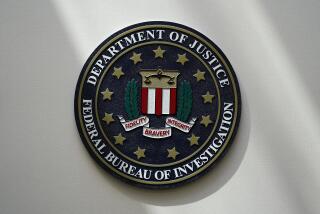Bin Laden worried about legacy and sought to kill Obama
WASHINGTON â In his final months padding around the dark third-floor room in his cinder-block Pakistan hide-out, the worldâs most notorious terrorist mastermind spent a lot of time in his own head.
He fretted about his public image and the legacy of his organization. He wondered whether he had misnamed it Al Qaeda. He fired off orders, handed out promotions, denied requests for help from the battlefield and sought to direct publicity for the looming 10th anniversary of the Sept. 11, 2001, attacks. And as well, he schemed to kill the man who would, in the end, give the order to shoot him dead: Barack Obama.
Thatâs the portrait of Osama Bin Laden painted by the slim collection of notes and letters made public Thursday by the Combating Terrorism Center, a think tank at the U.S. Military Academy at West Point. The 17 documents represent a sliver of the vast cache of material on computer hard disks, flash drives and DVDs that Navy SEALs scooped up from Bin Ladenâs compound after they found him a year ago in his bedroom and put a bullet in his face.
The documents offer few revelations about how Bin Laden evaded the U.S. for nearly a decade. But they do provide, with granular detail, selective insights into the mind of the terrorist leader during the years he was on the run.
What is missing from the tightly controlled release are details of who may have protected him, and how Americaâs Public Enemy No. 1 had spent years just a mile from Pakistanâs own version of West Point, the prestigious Kakul military academy in Abbottabad.
During those years, the documents indicate, Bin Laden was haunted by Al Qaedaâs failures and sought to recast his revolution. He concerned himself with the organizationâs inabilities to launch a second large-scale attack in the U.S., to capitalize on resentment that fueled the âArab Springâ and to retain the trust and loyalty of Sunni Arab tribes in western Iraq.
Al Qaedaâs experience in Iraq weighed heavily on Bin Laden. He saw how beheadings and indiscriminate bombings that led to scores of Muslim civilian deaths turned the tribes against the group, pushing tribal leaders into an alliance with the U.S. military. He did not want to see this happen again and warned the leader of his affiliate in Yemen to treat tribal leaders carefully.
âBin Laden appeared to be deeply concerned that affiliates could go too far by killing too many people,â said Seth Jones, an expert on Al Qaeda at the Santa Monica-based Rand Corp. think tank and author of âHunting in the Shadows: The Pursuit of al Qaâida Since 9/11.â
Concerned that a âlarge portionâ of Muslims had lost their trust in Al Qaeda, Bin Laden even floated new names for his organization. He felt that continuing to call the group Al Qaeda âreduces the feeling of Muslims that we belong to them.â
Al Qaeda means âthe baseâ and was a name that emerged from the organizationâs origins in the base camps for fighters in Pakistan training to launch attacks on Soviet forces occupying Afghanistan in the 1980s. Bin Laden pondered ideas for a new name to better embrace the Muslim world, the contenders including: Muslim Unity Group, Islamic National Unification Party or Monotheism and Jihad Group.
Bin Laden continued to order that holy war be waged thousands of miles away, even as he remained within his compound. He could only see the world in shadows, flickering on his television set and computer screen, described to him through letters and Arabic translations of American news reports.
As a result, he developed a sort of talk radio view of U.S. politics. At the same time, he could no longer trust that his commands were being followed, or whether his subordinates still revered him.
âI donât think he had understood that Al Qaeda had long passed him by. I think he thought that by doing what he knew â top down management â he could get it back, but no one was listening,â said Jarret Brachman, a consultant to the U.S. government on the leadership of terrorist organizations and the author of âGlobal Jihadism: Theory and Practice.â
Among the plans that never came to fruition was a plot to kill President Obama.
Bin Laden ordered a lieutenant to set up a terrorist team near Bagram air base in Afghanistan that would be ready to blow up the presidentâs plane if he arrived for a surprise visit, as he eventually did on Tuesday, the first anniversary of Bin Ladenâs death.
Bin Laden wrote in a letter to one of his lieutenants that assassinating Obama would put a âtotally unpreparedâ Vice President Joe Biden in charge of the country, âwhich will lead the U.S. into a crisis.â
Despite a deepening sense that his organization was being fractured by a relentless covert campaign of U.S. drone strikes that killed some of his most trusted aides, Bin Ladenâs preference for spectacular attacks, as opposed to pin prick strikes, remained strong, as well as his obsession with airplanes.
He also continued to express a need to maintain personal control, demanding that affiliates in Yemen, Somalia and North Africa stop fighting regional battles and help him focus on attacking the West.
Given the American focus on the Horn of Africa, Bin Laden was concerned about militants in Somalia coming under increased U.S. military pressure and economic sanctions if Al Qaeda offered its public support. He told the head of the Yemen affiliate that he shouldnât declare an Islamic state there as long as âthe enemy continues to possess the ability to topple any state we establish.â
The small selection of letters seems to show a Bin Laden who may have grown apart from his long-time deputy, Egyptian-born surgeon Ayman Zawahiri, and come to rely on the judgment of Libyan-born Atiyah Rahman, who was killed in a predator drone strike in August 2011. In the letters, Rahman and Bin Laden also lament the rash and short sighted leadership shown by a new generation of leaders rising through the ranks.
âIt is clear that the documents that paint a negative portrait of Al Qaeda, they [the Obama administration] wanted out,â said a former U.S. official familiar with the intelligence haul who spoke under the condition of anonymity in order to discuss sensitive material.
Seeing a more three-dimensional portrait of Bin Laden would require the release of a more representative batch of the documents, said Bill Roggio, managing editor of the Long War Journal, a website that tracks terrorist groups and is funded by the Foundation for the Defense of Democracies, a right-leaning think tank in Washington.
âI think that nearly all of Osama bin Ladenâs files should be declassified and released to the public, not just a tiny fraction of them,â said Roggio.
More to Read
Sign up for Essential California
The most important California stories and recommendations in your inbox every morning.
You may occasionally receive promotional content from the Los Angeles Times.











